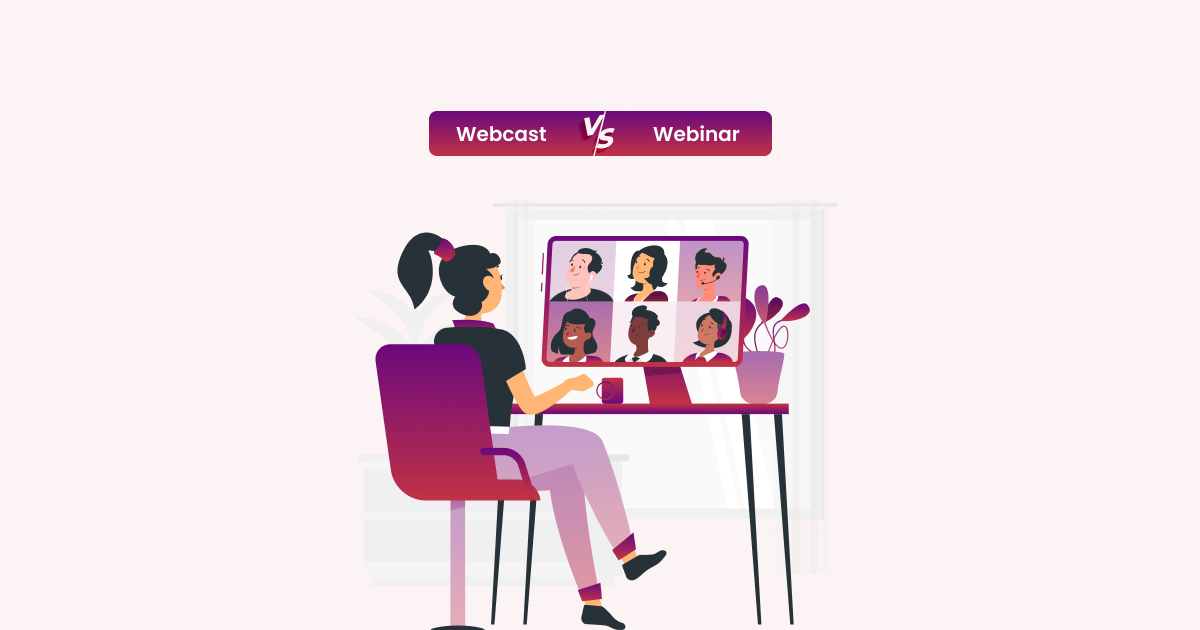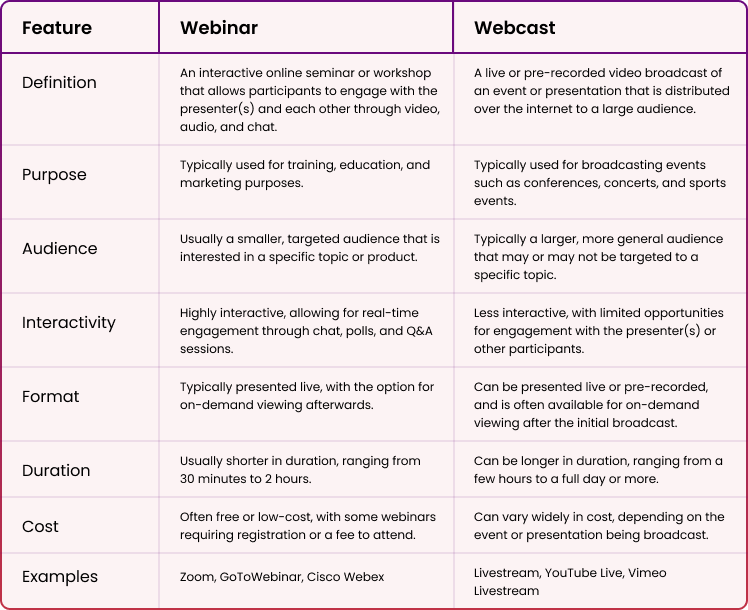Webinars and webcasts are similar marketing tools. Companies use them to highlight different strengths and reach large audiences without spending a lot of money. While these marketing tools may share a similar purpose, there are some key differences between them. Here is a look at the differences between a webcast vs webinar.
Webinar Explained
A webinar is an online presentation. These events are generally structured with a speaker highlighting different points to a virtual audience. One of the key benefits of a webinar is that people are able to watch it all over the World in real-time. It’s a convenient way to bring people together. Attendees often participate in the presentation through live chat and also ask post-webinar survey questions.
Speakers may express their message using a whiteboard, webcam, or PowerPoint presentation. They can use popular tools like Zoom, Youtube, Go to Webinar, and webinar plugins like WebinarPress to conduct their webinar. Most attendees watch webinars looking to gain knowledge. Webinars are often exclusive, with an average size between 400 and 800 people. These events are normally very professional, which adds to the appeal. Webinars are also generally available on demand. You can watch, download, or send links whenever it’s most convenient for you.
Benefits of Using a Webinar
Companies use webinars when they are trying to interact with their audience in a live setting. It’s a great way to promote products, express new ideas, and generate leads. Some companies use webinars to help train their employees. Companies believe that webinars are an effective way to teach because employees can learn at their own pace. Webinars are a great way for companies to market a new product, train employees, educate them and engage their audience.
Webcast Explained
A webcast is a traditional broadcast that takes place online. Webcasts are generally structured to engage the audience. The hosts are simply explaining their message while the audience watches and listens.
Webcasts may be pre-recorded more often than they are live. However, webcasts are still designed to reach thousands of people at a time. There’s a significant financial investment involved in most webcasts to give them a professional, almost TV-like feel. There are generally high-quality events for companies to make major announcements.
Webcasts often allow local people to attend while also streaming the event. Some webcasts do allow people to ask questions or take a survey once the event has been completed.
Webcasts are also available in multiple ways, including PowerPoint presentations, audio clips, and video files. Webcasts may include multiple guest speakers. Webcasts are easily transmitted from one site to another and across social media channels, which increases engagement. As previously noted, most webcasts potentially reach millions of people due to their structure.
When to Use a Webcast
Webcasts are ideal for companies who have a major announcement at a town hall, are hosting a conference, are having a panel discussion/review, or launching a new product. Many of these events are not open to the public, which is why companies use webcasts to get information out. Webcasts allow companies to maintain an exclusive feel while still allowing the public to learn about what’s going on.
Webinar Types
Webinars are versatile. Companies can utilize multiple types of webinars formats depending on their audience’s needs. The primary goal is to use a webinar that suits your business strengths and appeals to your audience. Live tutorials are an option if you have a remote workforce. You can train them and inform them about company guidelines without having to meet in person.
Many companies use webinars to launch a new product. The audience has a chance to learn about the product’s new features. You can enhance the marketing strategy for the launch by making it exclusive to your top customers or keeping the entire thing a secret until the webinar starts. Maybe your audience believes that the product is more difficult to use. You can host a demo webinar or go over the instruction manual. Some companies also use webinars to introduce a new series. This strategy can help you generate new leads depending on the topic being covered.
Types of Webcasts
Webcasts stand out for their size. Companies use webcasts when they would like to create a big event. Companies that host a festival or big conference may use the webcast to interact with millions of people around the World.
Companies also use webcasts to announce breaking news. Webcasts are also used to support people who stay in different time zones. Webcasting allows people all over the World to enjoy a thrilling viewing experience.
Key Differences Between Webinar and Webcast
There are some differences when comparing webinars vs webcasts. Size is a major one. Webinars may have multiple speakers, but they have limited attendance. The cap is often somewhere around 900–950 participants, with a 1,000 maximum.
Webcasts are much larger and often exceed thousands of viewers. There’s normally only one host. There’s also a lack of interaction between the host and attendees. Direct engagement means that webinars are often more focused.
Webinars may be live or pre-recorded. Webcasts are often live, but they may be taped as well. Making the services available on demand makes it easy for people all over the World to attend as long as they have an internet connection.
There may also be differences in the goals of each service. Most webinars are directly created to interact with the audience. Webinars even allow attendees to interact with each other in small group chats. However, webcasts focus on recording information and sharing it. Normally streams aren’t hosted by a particular domain and are instead available through multiple platforms. The compatibility with multiple platforms makes webcasts user-friendly even without direct engagement.
When to Choose a Webinar
Hosting a webinar is the right choice if you want to interact with attendees. Having a live, festive atmosphere can help improve your lead conversion rates. Be aware that too many attendees viewing the webinar may cause engagement issues, and you’ll be unable to provide value to everyone as intended. You’ll also have to choose the right webinar platform as well. A bad connection could damage the webinar’s quality.
When to Choose a Webcast
Opt for a webcast if you want to inform a large group of people. The lack of interaction may be a weakness. Another option is to use webcasts as an extension of your webinars. Save huge announcements for your webcast and open up potential questions regarding it on your webinar.
Summary of Webinar vs Webcast
Webinars allow you to maximize your ROI by interacting with your attendees. Webcasts are better if you want to expand your outreach without engaging people. Webcasts and webinars both serve important functions. Sit down with your team and figure out your sales and marketing goals. That will make it easier for you to figure out which option is best at the moment.
Hybrid Option
There is another option to consider: a virtual event. Virtual events combine the features of webinars and webcasts into an exciting package. Virtual events are large, which allows you to reach the same number that you would if you hosted a webcast. The event will also include similar aspects of a webinar. You can offer real-time webinar survey questions and set up breakout rooms and virtual stands. This allows participants to interact with each other and listen to smaller addresses.
Also Read: Podcast vs Webinar: Which is better?
FAQs
How Do the Costs of Hosting a Webcast and Webinar Compare?
Hosting webinars or webcasts may cost $2,000, depending on the equipment you’re using. You’ll need to purchase a laptop and webcam to reach the audience. You’ll also need a good webcam to enhance the experience. Most webcams are equipped with microphones, but you also have the option to purchase one if you’re concerned about sound quality.
The more money you invest in equipment, you’ll have to put more effort into delivering a great webinar to generate ROI.





